Stamford School
Stamford School is an English independent school for boys in the market town of Stamford, Lincolnshire. Founded in 1532, it has been a member of the Headmasters' and Headmistresses' Conference since 1920. With the girls-only Stamford High School and the coeducational Stamford Junior School, it is part of the Stamford Endowed Schools (SES).
| Stamford School | |
|---|---|
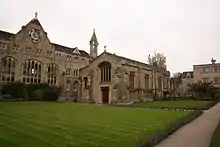 | |
| Address | |
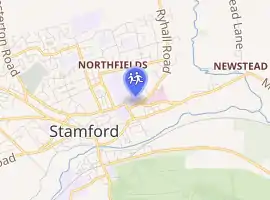
| |
St Paul's Street , , PE9 2BQ England | |
| Coordinates | 52.65520°N 0.47166°W |
| Information | |
| Type | Public school Independent day and boarding |
| Motto | Christ Me Spede |
| Established | 1532 |
| Founder | William Radcliffe |
| Principal of SES | William Phelan |
| Headmaster | Nick Gallop |
| Gender | Boys |
| Age | 11 to 18 |
| Houses | Ancaster, Brazenose, Exeter, Radcliffe. Boarding – Byard, Browne |
| Colour(s) | Navy, maroon |
| Publication | The Stamfordian |
| Former pupils | Old Stamfordians |
| Website | https://www.stamfordschools.org.uk/our-schools/stamford-school |

History
The school was founded in 1532[1] by a local merchant and alderman, William Radcliffe, who had been encouraged when younger by Lady Margaret Beaufort, (died 1509) mother of Henry VII, though there is evidence to suggest that a school existed from the beginning of the fourteenth century. Founded as a chantry school, it fell foul of the Protestant reformers and was only saved from destruction under the Chantries Act of Edward VI by the personal intervention of Sir William Cecil (later Lord Burghley) who worked in the service of Edward Seymour, 1st Duke of Somerset and who secured a specific Act of Parliament in 1548 ensuring its survival. Apart from the chantries of the University of Oxford and the University of Cambridge, only those of Eton College, Winchester College, Berkhamsted, St Albans and Stamford schools survived.
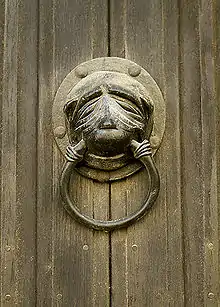
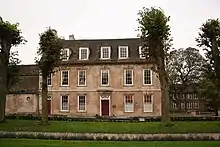
Teaching is believed to have begun in the Corpus Christi chapel of Stamford's twelfth-century church of St Mary, but by 1566 was taking place in the remaining portion of the redundant St Paul's Church, originally built no later than 1152. This building continued in use as a school room until the early twentieth century when it was restored and extended and, in 1930, returned to use as a chapel. In 1961, a nineteenth-century Gray and Davison pipe organ was installed[2] although this was removed in the 1990s and replaced with an electronic substitute. Over its history the school has built or absorbed seventeenth-, eighteenth- and nineteenth-century buildings, besides the site of a further demolished medieval church (Holy Trinity/St Stephen's) and remains of the hall of Brasenose College built by the secessionists from the University of Oxford in the fourteenth century. Brasenose College bought Brazenose House in 1890 to recover the original medieval brass Brazenose knocker.[3][4]
The right of appointment of the school's master, a position hotly contested in past centuries on account of the post's disproportionately large salary, was shared between the Mayor of Stamford and the Master of St John's College, Cambridge. Both Stamford Town Council and St John's College still have nominees on the school's governing body. Stamford School has a sister school, Stamford High School which was founded in 1877. The funds for the foundation of the High School and the further financial endowment of the existing boys' school were appropriated from the endowment of Browne's Hospital by Act of Parliament in 1871. This trust had been established for the relief of poverty by William Browne (died 1489), another wealthy wool merchant and alderman of the town, and his gift is commemorated in the name of a school house.
From 1975, Lincolnshire County Council purchased places at Stamford School and Stamford High School on the basis that Stamford had no LEA grammar school (unlike the county's other towns). This local form of the Assisted Places Scheme provided funding to send children to the two schools that were formerly direct-grant grammars.[5] The national Assisted Places Scheme was ended by the Labour government in 1997 but the Stamford arrangements remained in place as an increasingly protracted transitional arrangement. In 2006, Lincolnshire County Council agreed to taper down from 50 the number of county scholarships to the Stamford Endowed Schools so that there would be no new scholarships from 2012.[6][7]
In recent years, the two schools have been united under the leadership of a single principal as the Stamford Endowed Schools. This organisation now comprises Stamford Junior School, a co-educational establishment for pupils aged between 2 and 11 years, Stamford School for boys aged 11–18, and Stamford High School catering for girls of the same age group. Sixth Form teaching is carried out jointly between Stamford School and Stamford High School.
Stamford School has four senior (Y10–Y13) houses. These are called Brazenose, Radcliffe, Ancaster and Exeter. There are also four junior house systems, each the same colour as their senior counterparts, and these are named St Peter's, St Paul's, Willoughby and Cecil. There are also three boarding houses: Byard, for boys aged 11 to 14; St Paul's, for boys aged 14 – 16; and Browne, which houses boys aged 16 to 18. The four junior (Y7–Y9) houses are Cecil (feeder house to Exeter), Willoughby (feeder house to Ancaster), St Paul's (feeder house to Radcliffe) and St Peter’s (feeder house to Brazenose). Brazenose and Radcliffe traditionally housed town boys, while Ancaster and Exeter accommodated boys who lived respectively north and south of the River Welland. Additional boarding houses within the Stamford Endowed Schools are St Michael's (boys and girls 8–11), St Martin's (girls 11-13), Welland (girls 13–16) and Park (girls 16–18).
Since 1885 The Stamfordian has been the school magazine of Stamford School. Currently published annually in the Autumn term, it provides for current pupils and parents as well as Old Stamfordians and prospective parents an account of a year in the life of the school.
The school has rivalries with nearby Uppingham School, Oakham School and Oundle School.
School crest
The school's crest is a stork (the spede bird) with wings displayed on a wool bale over the motto + me spede, that is Christ me spede. The emblem was adopted from medieval wool merchant, William Browne, after the school had been re-endowed from Browne's Charity in 1873.[8] (The stork is supposed to be a rebus on his wife, Margaret's maiden name of Stoke). The current form was designed by Nelson Dawson.
Notable alumni (Old Stamfordians)
Politics and public service
- Nick Anstee, Lord Mayor of London[9]
- Simon Burns, Conservative MP for West Chelmsford, Minister of State[10]
- John Cecil, 5th Earl of Exeter, MP for Stamford, Grand Tourist and connoisseur
- William Cecil, 1st Baron Burghley, Lord High Treasurer of England and chief advisor to Queen Elizabeth I
- Alfred Harmsworth, 1st Viscount Northcliffe, newspaper magnate, founder of the Daily Mail and Daily Mirror, owner of The Times
- J. F. Horrabin, Labour MP for Peterborough, journalist and broadcaster
- Sir Thomas Wilson, author, translator, diplomat, Member of Parliament, Keeper of the King's Records
Law
- Sir Richard Cayley, QC, Chief Justice of Ceylon
- Sir Ronald Long,[11] President of The Law Society
Music
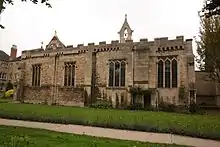
- Sir Malcolm Sargent,[12] conductor
- Sir Michael Tippett, composer
- Julian Wastall, composer
Literature and the arts
- Michael Asher FRSL, author and explorer
- Torben Betts, playwright
- Nelson Dawson,[13] silversmith, jeweller, designer, etcher and painter of the Arts and Crafts movement.
- Colin Dexter, OBE, author of the Inspector Morse detective novels; Morse is described as an Old Stamfordian
- Neil McCarthy, film and television actor
- Francis Peck, antiquary
- John Radford, wine writer and broadcaster
- Ralph Robinson, Renaissance scholar, first translator into English of Thomas More's Utopia
- Thomas Seaton, founder of Seatonian Prize for Poetry at the University of Cambridge
- John Terraine, military historian
- Ben Willbond, film and television actor
The armed forces
Academia and the Church
- Martin Aitken, FRS, FSA, FRAS, FInstP, Professor of Archaeometry, University of Oxford, Fellow of Linacre College, Oxford
- Zachary Brooke, Lady Margaret's Professor of Divinity, University of Cambridge
- Henry Edwards, Dean of Bangor
- Charles John Ellicott, professor of Divinity at King's College London and the University of Cambridge and Bishop of Gloucester and Bristol
- Philip Goodrich, Bishop of Worcester
- Malcolm Jeeves, psychologist
- Steven V. Ley, CBE, FRS, FMedSci, BP (1702) Professor of Chemistry at the University of Cambridge, Fellow of Trinity College, Cambridge
- Cecil Richard Norgate,[15] Bishop of Masasi, Tanzania
- Ian Roberts, PhD, LittD, FBA, Professor of Linguistics University of Cambridge, Fellow of Downing College
- M. Stanley Whittingham, Winner of the 2019 Nobel Prize in Chemistry
Commerce and industry
- Oliver Hemsley, Chief Executive Officer, Numis Securities
Sport
- Robert Clift, gold medal winning hockey player at the 1988 Seoul Olympics
- Simon Hodgkinson,[16] England international rugby
- Mark James, golfer and captain European Ryder Cup team
- Shan Masood, Pakistani Test cricketer
- Alexander Sims, racing driver in Formula E
- M. J. K. Smith, England international rugby, England international cricket captain
- Iwan Thomas, MBE Olympic athlete
Notable schoolmasters
- Robert Browne, clergyman and founder of the Brownists
- William Dugard, headmaster of Merchant Taylors' School, Northwood, Royalist propagandist, printer of Basilikon Doron, a treatise on government written in 1599 by James VI of Scotland, the future James I of England
- Gerard Hoffnung, musician, humourist, cartoonist
- Gizz Butt, former live guitarist for The Prodigy
- Dean Headley,[17] Rugby and Cricket professional
See also
- History of Brasenose College, Oxford
- St Paul's Church, Stamford – The school chapel
Further reading
- B. L. Deed, OBE, TD, The History of Stamford School, Cambridge University Press, 1954 (1st edition); 1982 (2nd edition).
References
- http://www.ses.lincs.sch.uk/page/?pid=313
- Lincolnshire Stamford, Stamford School, St. Paul's Street [R01446], British Institute of Organ Studies, retrieved 19 March 2019
- Sheehan, Nicholas. "The Brazenose Site in Stamford". Stamford Local History Society. Retrieved 14 April 2017.
- Madan, F. "The Brazen Nose" (PDF). Brasenose College. Retrieved 14 April 2017.
- "Last stronghold of assisted pupils faces legal threat" by Julie Henry, The Daily Telegraph 23 March 2003
- "Stamford Endowed Schools Scholarship Tapering - Interim (8th Year) Review; 6 March 2015" (PDF). Lincolnshire.moderngov.co.uk. Lincolnshire County Council. Retrieved 17 March 2019.
- "Private pupils' subsidy to finish". BBC News. 5 July 2006. Retrieved 17 March 2019.
- "The staircase". Stamfordcivicsociety.org.uk. Retrieved 7 June 2020.
- "City of London Member Details". City of London. Retrieved 11 February 2012.
- "Which Tory went where?". The Guardian. London. 2 June 2007. Retrieved 11 February 2012.
- Obituary, Law Society Gazette
- "Sir Malcolm Sargent". iTunes. Retrieved 11 February 2012.
- "Nelson Dawson". Lincs to the Past. Retrieved 11 February 2012.
- "Sir Mike Jackson". Abingdon Speakers. Retrieved 11 February 2012.
- The Reverend Richard Norgate; Obituary in The Telegraph
- "Guy gets an England call". Rutland & Stamford Mercury. 8 March 2007. Retrieved 11 February 2012.
- "Where are they now? Dean Headley". Kent Cricket. Retrieved 11 February 2012.
External links
| Wikimedia Commons has media related to Stamford School. |
- Profile on the ISC website
- Stamford Endowed Schools website
- Photographs of Stamford School
- The Foundation Card
- The recent issues of the Stamfordian magazine can be downloaded
- Stamfordian 2005 (PDF 15MB)
- Stamfordian 2006 (PDF 10MB)
- Stamfordian 2007 (PDF 15MB)